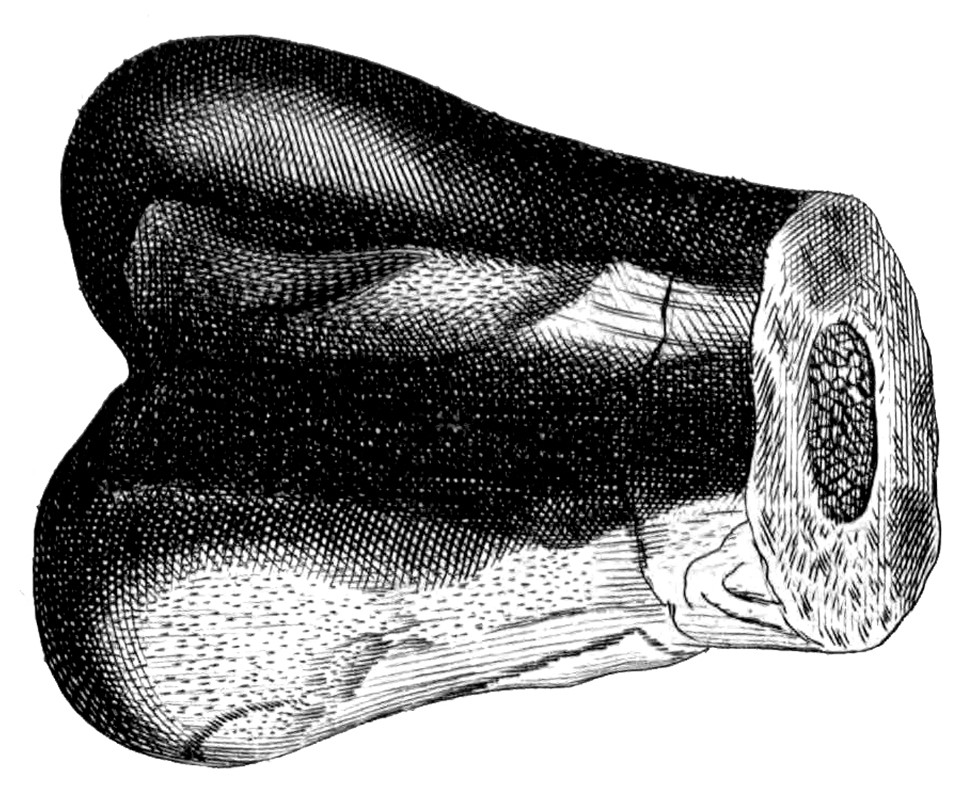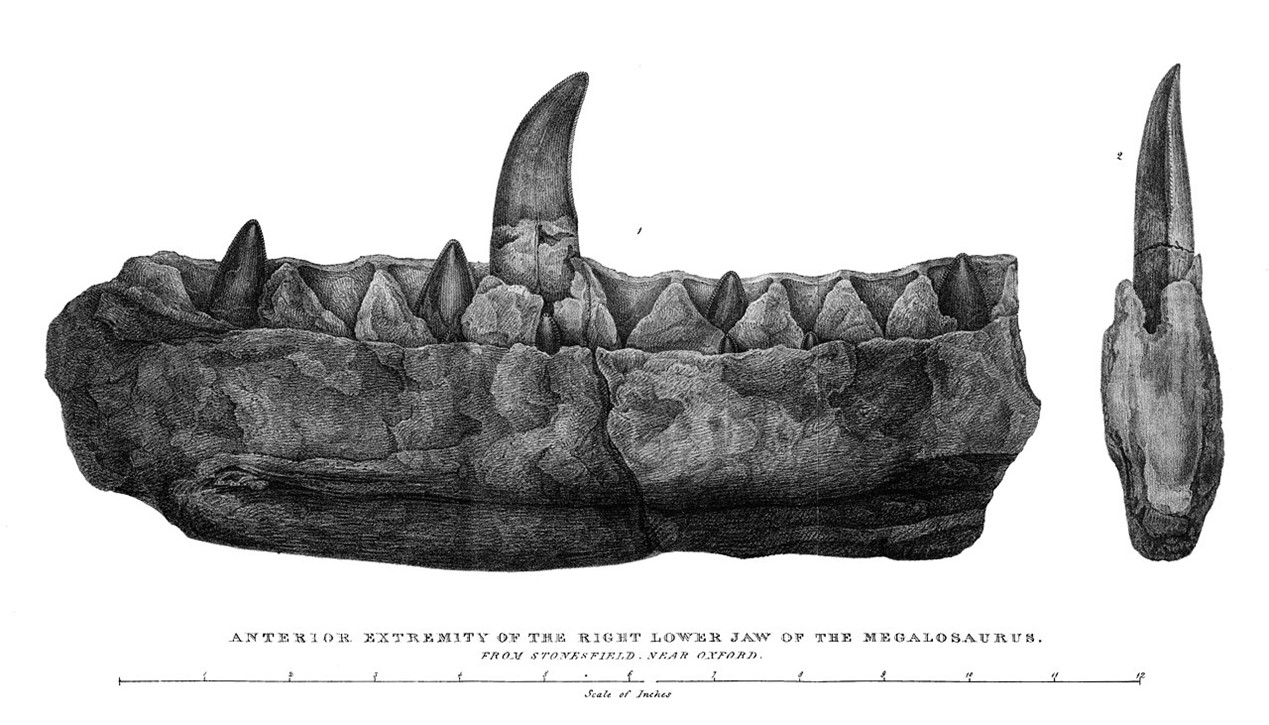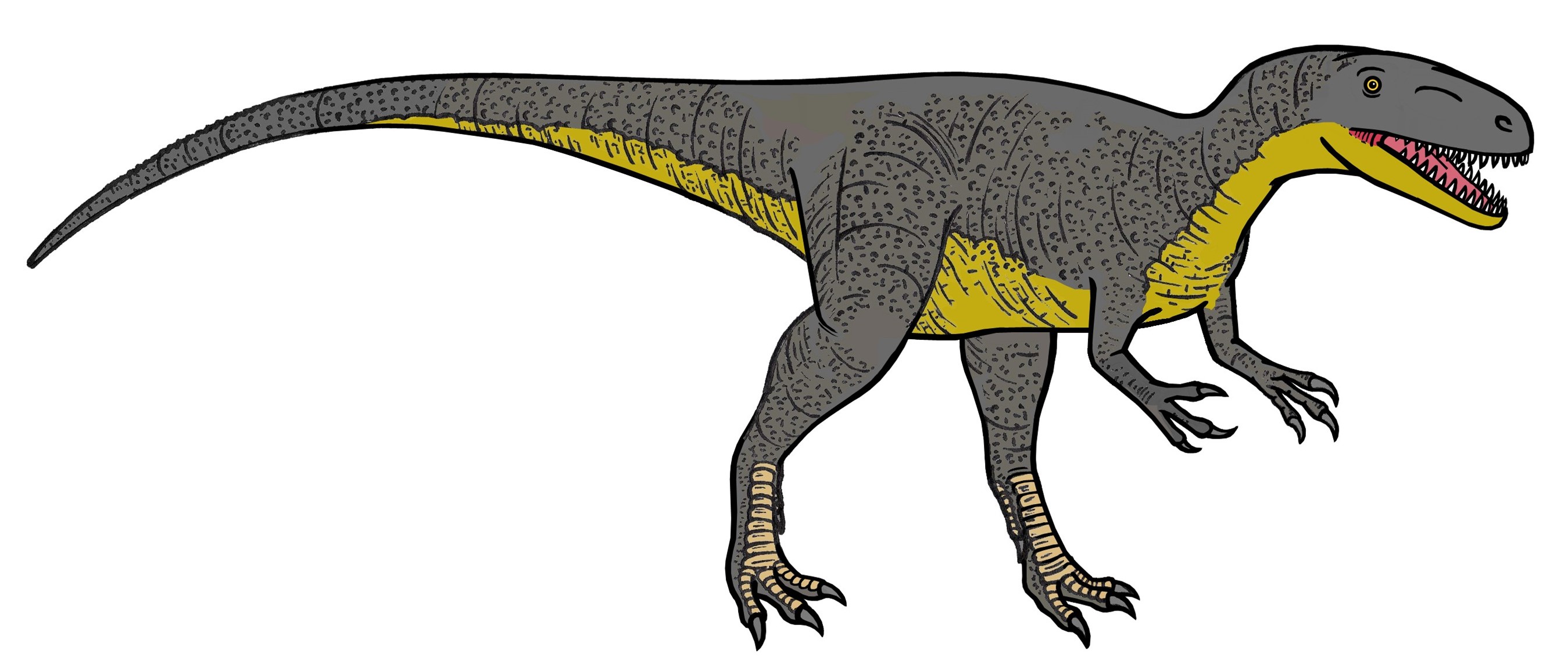
Credit: Robert Plot (1640–1696), public domain, via Wikimedia Commons
The first dinosaur fossil documented by a scientist was 350 years ago, in 1677.
It was part of a femur discovered in a shale mine in England, then sent to a local museum. The curator had never seen anything like it.
He thought it must be a thigh bone from a war elephant, from some ancient battle. Or the femoral head of a giant human, as described in the Bible.
At any rate, he published an illustration in his natural history of the area, but no one thought much of it.
One hundred and fifty years later, in 1824, Oxford University’s first geologist studied more fossils that had been found in English canals and quarries and concluded they came from an extinct giant reptile species. He named it Megalosaurus, “great lizard.”
He presented his findings to the Geological Society of London, and Megalosaurus entered the fossil record.
This triggered a fossil rush, and soon amateurs and professionals alike were finding more bones.
That’s when, in 1841, another scientist realized there were a host of these ancient creatures, which he dubbed “dinosaurs” after the Greek deinós for terrible, and saûros for lizard.
Since then, paleontologists have found dinosaurs far more “megalo” than Megalosaurus, which, it turns out, was an early theropod about half the size of T. rex.
But Megalosaurus started it all; the birth of a field that still fascinates humans 200 years later.
Background
Synopsis: In 1676, workers found a huge bone while quarrying shale near Oxford, England, that looked like it was the femur of an elephant or a giant human. In 1824, fossils from quarries in the area enabled William Buckland, the University of Oxford’s first geology professor, to propose the existence of an ancient lizard-like creature he called Megalosaurus. Seventeen years later, another scientist proposed the name “Dinosauria” for creatures like Megalosaurus. Megalosaurus was named even before dinosaurs were named.
- In 1676, a fossil was found in the Stonesfield Slate Quarry near Oxford, England.
- The giant bone that looked like a piece of an oversized femur was given to Robert Plot, the first curator of the Ashmolean Museum and Professor of Chemistry at the University of Oxford.
- Professor Plot sketched it and published a description of it in his 1677 Natural History of Oxford-shire. This is the earliest known published illustration of a dinosaur bone.

Cover of Robert Plot’s Natural History of Oxford-shire, 1677.
Credit: Robert Plot (1640–1696), public domain, via Wikimedia Commons - He concluded that it was either the thigh bone of a war elephant or of a giant human as described in the Bible. Fossils often led their discoverers to imagine mythical creatures (ED-045 Fantastic Beasts).
- Two hundred years ago, in 1824, the University of Oxford’s first professor of geology, William Buckland, studied fossils of limbs, a lower jawbone, and some vertebrae found in nearby quarries and recognized that they came from a huge reptile-like creature that was not a known living species.
- The largest thigh bone was 33 in (84 cm) long and 10 in (25 cm) in diameter.
- He addressed the Geological Society of London on February 20, 1824, providing a formal scientific name for the fossil—Megalosaurus, meaning “great lizard.”
- Megalosaurus was the first dinosaur to ever be described and named in scientific literature.
- Buckland married his assistant, Mary Morland, an artist-naturalist who illustrated the Megalosaurus fossils in the famous paper.

Historical engraving of the lower jaw of Megalosaurus bucklandii, Oxford University Museum of Natural History.
Credit: Mary Morland (later Buckland; 1797–1857), public domain, via Wikimedia Commons - He thought the “lizard” would have been about 40 ft (12 m) long and that it walked on four legs like an elephant, living both on land and in the water.
- These early fossils were kept at the Oxford University Museum of Natural History and started a “fossil rush” as people began actively looking for giant bones around Europe.
- Seventeen years later, in 1841, these types of fossils were given the name “Dinosauria” by naturalist Richard Owen.
- Owen noted that large bones found in southern England belonging to Iguanodon (described in 1825), and Hylaeosaurus (described in 1833) formed a common group with Megalosaurus.
- Owen created the word “dinosaur” by combining deinós, the Greek word for terrible, with saûros, which means lizard. We now know dinosaurs aren’t lizards, but “terrible lizard” described what scientists saw in these early fossils.
- In the late 1850s, Hadrosaurus and Dryptosaurus fossils found in New Jersey showed that some dinosaurs were bipedal (they could walk on just two legs). Prior to this discovery, scientists imagined that all dinosaurs lumbered about on four legs.
- Scientists now know that Megalosaurus bucklandii was a Jurassic theropod dinosaur—a carnivore that walked on its hind legs and was about 20 ft (6 m) long.
- The only specimens of this particular dinosaur come from the Bathonian Age (166 million years ago) of Oxfordshire and Gloucestershire, England.

Reconstruction of Megalosaurus bucklandii, a Jurassic theropod dinosaur.
Credit: Conty, CC BY-SA 3.0, via Wikimedia Commons - A complete Megalosaurus fossil has never been found; paleontologists have identified only one species of Megalosaurus.
- Its much younger therapod cousin, Tyrannosaurus rex, lived throughout North America from about 74 million to 66 million years ago. Tyrannosaurus rex was twice as long and eight times as heavy as Megalosaurus.
- Megalosaurus lived alongside other therapods like Cruxicheiros, Iliosuchus and Streptospondylus as well as sauropods Cardiodon and Cetiosaurus.
- In the 19th and early 20th centuries, Megalosaurus was often illustrated living alongside Iguanodon, but Iguanodon was a younger species from the Early Cretaceous Period (145 million years ago).
- The only specimens of this particular dinosaur come from the Bathonian Age (166 million years ago) of Oxfordshire and Gloucestershire, England.

